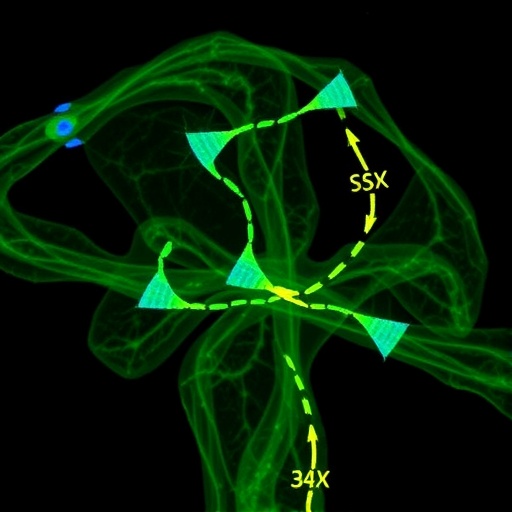In a groundbreaking advancement for osteoporosis therapy, a team of scientists has uncovered a novel molecular mechanism that might revolutionize how we approach bone degeneration. The study, conducted by Ma, Wang, Xue, and colleagues, identifies Msx2 as a critical regulator that acts as a molecular “brake” controlling the fusion of osteoclasts—cells responsible for bone resorption. Their findings not only deepen our understanding of the cellular and genetic pathways governing bone remodeling but also offer promising therapeutic avenues for combating osteoporosis, a disease that affects millions worldwide and leads to increased fracture risk and debilitating bone loss.
Osteoporosis emerges when the balance between bone formation by osteoblasts and bone degradation by osteoclasts tips unfavorably, resulting in net bone loss. Traditionally, therapies have aimed either to inhibit osteoclast activity or stimulate osteoblast-driven bone formation, but these strategies often come with limitations or side effects. What this new research introduces is the conceptualization of Msx2, a transcription factor, as a gatekeeper in the fusion process of osteoclast precursors. Preventing excessive fusion can modulate osteoclast activity more precisely, potentially minimizing adverse effects common to broad-spectrum anti-resorptive drugs.
At the cellular level, osteoclasts undergo a unique fusion process wherein multiple mononuclear precursors merge to form large, multinucleated cells capable of resorbing extensive bone matrix. This fusion enhances the bone-resorbing capacity but unchecked fusion can exacerbate bone loss in osteoporosis. By dissecting the molecular pathways that govern this fusion, the researchers have pinpointed Msx2 as an inhibitory element, effectively restraining how extensively these cells fuse and thus opening a window to regulate their destructive potential without fully halting their essential biological roles.
.adsslot_tgoWb6qdv9{ width:728px !important; height:90px !important; }
@media (max-width:1199px) { .adsslot_tgoWb6qdv9{ width:468px !important; height:60px !important; } }
@media (max-width:767px) { .adsslot_tgoWb6qdv9{ width:320px !important; height:50px !important; } }
ADVERTISEMENT
The research team employed an array of sophisticated biochemical and genetic techniques, ranging from knockout mouse models to single-cell transcriptomic analyses, to unravel how Msx2 functions within osteoclast lineage cells. Their results showed that Msx2’s expression is selectively elevated in fusion-stage osteoclast precursors and surprisingly acts downstream of signaling cascades that promote cell differentiation. This finding underscores the complexity of controlling osteoclast activity: Msx2 does not impede differentiation but fine-tunes the fusion process, a subtlety that could be exploited for therapeutic precision.
Crucially, the study moves beyond in vitro systems to explore the translational potential of targeting Msx2. By manipulating Msx2 expression in pre-clinical osteoporosis models, the investigators achieved not only a reduction in pathological bone resorption but also observed anabolic, or bone-building, effects. This duality is particularly striking as it suggests that Msx2 targeting could restore the delicate equilibrium between bone destruction and formation, a feat rarely accomplished by current treatments which typically prioritize one side of the equation.
The identification of Msx2’s involvement aligns with other recent advances in understanding bone homeostasis as a tightly regulated interplay of cellular fusion, differentiation, and signaling feedback loops. Msx2 appears to act at the crossroads of these pathways, integrating environmental cues and cellular states to maintain skeletal integrity. This mechanistic insight opens new doors for drug discovery, focusing on molecules or modalities that can modulate Msx2 activity with high specificity.
Therapies that fine-tune osteoclast fusion, rather than bluntly inhibiting osteoclast survival or differentiation, promise improved safety profiles. Classical anti-resorptives like bisphosphonates and denosumab often lead to side effects ranging from atypical fractures to osteonecrosis of the jaw. The Msx2 axis, by contrast, may allow for selective attenuation of excessive fusion and bone breakdown without completely disrupting physiological bone remodeling essential for bone renewal and health.
Moreover, the work elucidates potential crosstalk between Msx2 and other regulatory proteins integral to osteoclast fusion, such as DC-STAMP and OC-STAMP, known mediators of precursor cell fusion. Msx2 appears to repress these fusion-promoting factors, suggesting a feedback mechanism whereby Msx2 levels might serve as a natural “rheostat” or checkpoint during osteoclastogenesis. Understanding this multilayered regulation could further refine therapeutic interventions aiming to restore bone strength.
Given the prevalence of osteoporosis—affecting hundreds of millions globally—therapeutic breakthroughs are urgently needed, especially treatments that can be tailored to individual patient profiles with minimal risk. The discovery of Msx2’s pivotal role could pave the way for personalized medicine approaches, wherein patients with heightened osteoclast fusion activity might benefit most from Msx2-targeted treatments, reducing fractures and improving quality of life.
The research delivers compelling evidence that output from osteoclast-osteoblast crosstalk is finely tuned by factors like Msx2, which integrate signals to balance tissue remodeling. The observation that Msx2-targeted treatments stimulated bone formation while inhibiting excessive resorption could challenge existing dogmas and inspire a new class of anabolic agents derived from knowledge of cell fusion regulators.
Looking ahead, the translation of these findings into clinical therapies will require thorough investigation. Issues such as delivery methods for Msx2 modulators, off-target effects, and long-term outcomes must be rigorously assessed. Nonetheless, the preclinical success detailed by Ma et al. provides a strong foundation for future trials and drug development pipelines aiming to harness the fusion brake mechanism.
In an era where aging populations worldwide are driving unprecedented increases in osteoporosis prevalence, innovations like the identification and targeting of Msx2 represent a beacon of hope. By moving away from blunt suppression toward physiological modulation of osteoclast dynamics, this research epitomizes the future of bone disease therapeutics—smart, selective, and based on detailed cellular understanding.
Collaboration between molecular biologists, pharmacologists, and clinicians will be pivotal to optimize Msx2-based strategies and integrate them into existing treatment frameworks. The study’s comprehensive insights offer not only a novel target but also a conceptual framework to inspire new experimental questions about bone biology and pathologies driven by imbalanced cellular fusion.
Ultimately, the discovery that Msx2 serves as a molecular brake to osteoclast fusion rewires our understanding of how bone resorption is controlled and establishes a promising new target for anabolic osteoporosis therapies. This breakthrough highlights the power of combining cutting-edge genetic tools with translational models to discover innovative interventions that could transform millions of lives affected by skeletal fragility.
Subject of Research: Osteoclast fusion regulation and anabolic therapy development in osteoporosis
Article Title: Targeting Msx2 as a brake in the fusion fate of osteoclasts and an anabolic therapy in pre-clinical models of osteoporosis
Article References:
Ma, Q., Wang, S., Xue, H. et al. Targeting Msx2 as a brake in the fusion fate of osteoclasts and an anabolic therapy in pre-clinical models of osteoporosis.
Nat Commun 16, 7228 (2025). https://doi.org/10.1038/s41467-025-61938-0
Image Credits: AI Generated
Tags: anti-resorptive drug side effectsbone growth promotionbone resorption control mechanismscellular pathways in bone degenerationenhancing bone density therapiesmolecular mechanisms of bone remodelingMsx2 gene regulationnovel treatment strategies for osteoporosisosteoblast and osteoclast balanceosteoclast fusion inhibitionosteoporosis therapy advancementstranscription factors in bone health






